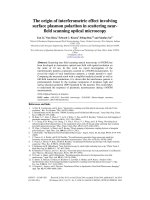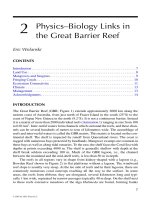Angular gating and biological scattering in optical microscopy
Bạn đang xem bản rút gọn của tài liệu. Xem và tải ngay bản đầy đủ của tài liệu tại đây (1.98 MB, 196 trang )
ANGULAR GATING AND BIOLOGICAL
SCATTERING IN OPTICAL MICROSCOPY
SI KE
NATIONAL UNIVERSITY OF SINGAPORE
2011
ANGULAR GATING AND BIOLOGICAL
SCATTERING IN OPTICAL MICROSCOPY
SI KE
B. Eng. (Hons.), Zhejiang University, China
A THESIS SUBMITTED
FOR THE DEGREE OF DOCTOR OF PHILOSIPHY
I
Acknowledgements
My thesis is a result of an exciting journey first undertaken in 2007. During the
four years research study in National University of Singapore, I have met many
nice people who helped me and gave me big encouragement:
First and foremost, I would like to express my sincere appreciation to my
supervisor Prof. Colin J. R. Sheppard for his supervision and guidance throughout
my postgraduate study. It is also very impressive that Prof. Colin is always
willing to find the time to sit down and discuss and solve problems with us, just
like a good friend. I believe and appreciate that Prof. Sheppard has an
extraordinary impact on my future research career. Without his invaluable
suggestions and patient discussions, this thesis could not be completed.
I am also grateful for my co-supervisor Prof. Hanry Yu and Dr. Chen Nanguang,
who taught me useful knowledge on optics and biology research and gave me a
lot of useful discussion, especially on the experiments. I enjoyed every discussion
with them and will never forget their valuable advices and contributions. I greatly
appreciate the generous support from Prof. Teoh Swee Hin and Dr. Chui Chee
Kong for their guidance for my lab rotation project. I would also thank my thesis
advisory committee member Dr. Huang Zhiwei for his scientific inputs and
continuous support. His valuable during my PhD qualification exam helps me to
steer more smoothly towards the completion of this thesis work.
I would like to thank for the enthusiastic discussions and suggestions given by my
coworkers and team members: Waiteng, Shakil, Elijiah, Shanshan, Shalin and
Naveen. I also would like to thank the support and understanding of all the other
students and staff in Optical Bioimaging Laboratory, especially Dr. Zheng Wei,
Dr. Gao Guangjun, Shau Poh Chong, Teh Seng Knoon, Liu Linbo, Shao
Xiaozhuo, Lu Fake, Mo Jianhua, Zhang Qiang, Chen Ling, and Lin Kan.
My special thanks also to my parents, it is their love that makes me become the
happiest person in the world. I am also willing to express my most special thanks
to my wife Dr Gong Wei for her support and understanding. Despite how hard the
reverse and difficulty are, she always believes in me and offers me support and
encouragement.
Last but not least, I would like to acknowledge the financial support from NGS
(NUS Graduate School for Integrative Sciences &Engineering).
II
Table of Contents
Acknowledgements ………………………………… ………………………… I
Table of Contents …………………………………………………….…………II
Summary ………………………………….……………………………… … V
List of Publications …………………………………………………………VII
List of Tables ……………………………………………………………………X
List of Figures ………………………………………………………………….XI
List of Abbreviations ………………………………………………………XVI
Chapter 1 Introduction ………………………………………………………….1
1.1 Background ……………………………………………………………1
1.2 Motivation…………………….….………………………………… 3
1.2.1 Light scattering modeling…………………….…………5
1.2.2 Angular gating techniques……………………………………8
1.3 Significance of the research ………………………………………….12
1.4 Structure of the thesis ……………………………………………… 14
Chapter 2 Literature reviews………………………………………………… 18
2.1 Conventional scattering models.….………………………………… 18
2.1.1 Discrete model…………………………………………….18
2.1.2 Fractal model…………………………………………………23
2.2 Optical microscopy …………………………………………….27
2.2.1 Confocal microscopy…………………………………… 27
2.2.2 Multi-photon microscopy… ………………………… …… 29
III
2.2.3 4Pi microscopy…………………….………………………….32
Chapter 3 Model for light scattering in biological tissue and cells ……40
3.1 Introduction………………………………………………………… 40
3.2 Discrete model with rough surface nonspherical particles……….41
3.3 Fractal model in biological tissue………………………………… …51
3.4 Conclusion……………………… ………………………………….57
Chapter 4 Confocal microscopy using angular gating techniques………… 61
4.1 Introduction………………………………………………… ….… 61
4.2 Confocal scanning microscope with D-shaped apertures………… …63
4.2.1 Coherent transfer function ………………………… ……….64
4.2.2 Optical transfer function………………………………………68
4.3 Confocal scanning microscope with off-axis apertures………… 73
4.4 Confocal scanning microscope with elliptical apertures………… …81
4.5 Confocal scanning microscope with Schwartz apertures……………88
4.6 Conclusion…………………………………………………………….92
Chapter 5 One-photon focal modulation microscopy ………………………96
5.1 Introduction………………………….………………… ……………96
5.2 Principle of focal modulation microscopy…………….…………… 98
5.3 Optical transfer function……………………………… ………… 101
5.4 Axial resolution……………………………………………………103
5.5 Transverse resolution…………………………………………… 106
5.6 Background rejection capability……………………………………112
5.7 Signal level………………………………………………………… 113
IV
5.8 Conclusion………………………………………………………….115
Chapter 6 Two-photon focal modulation microscopy ……………………119
6.1 Introduction…………………………………………………………119
6.2 Ballistic light analysis……………………………………… …… 122
6.2.1 3D Optical transfer function…………………………………122
6.2.2 Axial resolution………………………………………….…126
6.2.3 Transverse resolution …………………………………… 128
6.3 Multiple-scattering analysis………………………………………131
6.4 Conclusion………………………….… ……………………………146
Chapter 7 Polarization effects in 4Pi microscopy…… ……………………149
7.1 Introduction…………………………………………………………149
7.2 Symmetry considerations……………………………… … 150
7.3 Illumination using two counter-propagating beams…………………153
7.4 Comparison of various geometries………………………………163
7.5 Discussion………………………………………………………….166
Chapter 8 Conclusions ……………………………………………………… 169
V
Summary
The main purpose of my work is to precisely and effectively explore biological
phenomenon in vivo by using optical method. To achieve this aim, my major
work focuses on two aspects: one is to solve the fundamental problems of lack of
precise optical scattering models for biological tissue and cells, and the other is to
establish a high performance optical microscopy. For the first aspect, we
developed a random nonspherical model and a fractal model for the biological
tissue and cells. These two models are introduced based on different fundamentals
and have different applications. The power spectrum of the contrast phase images
is investigated. The phase function, the anisotropy factor of scattering, and the
reduced scattering coefficient are derived. The effect of different size distributions
is also discussed. The theoretical results show good agreement with experimental
data. The application of this model in phase contrast microscopy is in process. For
the second aspect, we discuss the confocal microscopy with angular gating
techniques (divided apertures) and investigate the performance of focal
modulation microscopy (FMM), which modifies a confocal microscopy by a
combination of angular gating technique with modulation and demodulation
techniques. We analytically derived the three-dimensional coherent transfer
function (CTF) for reflection-mode confocal scanning microscopy with angular
techniques under the paraxial approximation and also analyzed the three-
dimensional incoherent transfer function (OTF) for fluorescence confocal
scanning microscopy with angular gating techniques. The effects on different
aperture shapes such as off-axis apertures, elliptical apertures, and Schwartz
apertures are investigated. FMM was introduced to increase imaging depth into
tissue and rejection of background from a thick scattering object. A theory for
image formation in one-photon FMM is presented, and the effects of detecting the
in-phase modulated fluorescence signal are discussed. Two different non-
overlapping apertures of D-shaped and quadrant apertures are studies. Two-
photon FMM was proposed by us at the first time. The enhanced depth
penetration permitted by two-photon excitation with the near-infrared photons is
particularly attractive for deep-tissue imaging. The investigation of the imaging
depth in an extension of single-photon FMM to two-photon FMM (2PFMM)
VI
allows the penetration depth to be three-fold of that in convention two-photon
microscopy (2PM). This result suggests that 2PFMM may hold great promise for
non-invasive detection of cancer and pre-cancer, treatment planning, and may also
server as a research tool for small animal whole body imaging. The effects of
different apodization conditions and polarization distributions on imaging in 4Pi
microscopy are also discussed. With radially polarized illumination, the
transverse resolution in the 4Pi mode can be increased by about 18%, but at the
expense of axial resolution.
VII
List of Publications
Journal papers
1. W. Gong, K. Si, X. Q. Ye, and W. K. Gu, “A highly robust real-time image
enhancement,” Chinese Journal of Sensors and Actuators, 9, 58-62 (2007)
2. W. Gong, K. Si, and C. J. R. Sheppard, “Light scattering by random
non-spherical particles with rough surface in biological tissue and cells,” J.
Biomechanical Science and Engineering, 2, S171 (2007)
3. K. Si, W. Gong, C. C. Kong, and T. S. Hin, “Visualization of bone material
map with novel material sensitive transfer functions,” J. Biomechanical
Science and Engineering, 2, S211 (2007)
4. W. Gong, K. Si, and C. J. R. Sheppard. “Modeling phase functions in
biological tissue,” Opt. Lett. 33, 1599-1601. (2008)
5. C. J. R. Sheppard, W. Gong, and K. Si, “The divided aperture technique for
microscopy through scattering media,” Opt. Express, 16, 17031–17038 (2008)
6. K. Si, W. Gong, and C. J. R. Sheppard, “ Three-dimensional coherent transfer
function for a confocal microscope with two D-shaped pupils,” Appl. Opt. 48,
810-817 (2009)
7. K. Si, W. Gong, and C. J. R. Sheppard, "Model for light scattering in
biological tissue and cells based on random rough nonspherical particles",
Appl. Opt. 48, 1153-1157 (2009).
8. W. Gong, K. Si, and C. J. R. Sheppard, “Optimization of axial resolution in
confocal microscope with D-shaped apertures,” Appl. Opt. 48, 3998-4002
(2009).
9. W. Gong, K. Si, and C. J. R. Sheppard, “Improvements in confocal
microscopy imaging using serrated divided apertures,” Opt. Commun. 282,
3846-3849 (2009).
10. K. Si, W. Gong, N. Chen, and C. J. R. Sheppard, “Edge enhancement for
in-phase focal modulation microscope”, Appl. Opt. 48, 6290-6295 (2009).
11. W. Gong, K. Si, N. Chen, and C. J. R. Sheppard, “Improved spatial resolution
in fluorescence focal modulation microscopy”, Opt. Lett. 34, 3508-3510
(2009).
12. W. Gong, K. Si, and C. J. R. Sheppard, “Divided-aperture technique for
fluorescence confocal microscopy through scattering media,” Appl. Opt. 49,
752-757 (2010).
13. W. Gong, K. Si, N. Chen, and C. J. R. Sheppard, “Focal modulation
microscopy with annular apertures: A numerical study,” J. Biophoton., doi:
10.1002/jbio.200900110 (2010).
14. C. J. R. Sheppard, W. Gong, and K. Si, “Polarization effects in 4Pi
microscopy,” Micron, doi: 10.1016/j.micron.2010.07.013 (2010).
VIII
15. K. Si, W. Gong, and C. J. R. Sheppard, “Enhanced background rejection in
thick tissue using focal modulation microscopy with quadrant apertures,” Appl.
Opt., doi:10.1016/j.optcom.2010.11.007 (2010).
16. K. Si, W. Gong, and C. J. R. Sheppard, “Penetration depth in two-photon focal
modulation microscopy
,” Opt. Lett., (submitted).
Conference presentations
1. W. Gong, K. Si, and C. J. R. Sheppard, “Light Scattering by Random
Non-spherical Particles with Rough Surfaces in Biological Tissue and Cells,”
The 4th Scientific Meeting of the Biomedical Engineering Society of
Singapore (2007).
2. K. Si, W. Gong, C. C. Kong, and T. S. Hin, “Application of Novel Material
Sensitive Transfer Function in Characterizing Bone Material Properties,” The
4th Scientific Meeting of the Biomedical Engineering Society of Singapore
(2007).
3. W. Gong, K. Si, and C. J. R. Sheppard, “Light Scattering by Random
Non-spherical Particles with Rough Surface in Biological Tissue and Cells,”
Third Asian Pacific Conference on Biomechanics, (2007)
4. K. Si, W. Gong, C. C. Kong, and T. S. Hin, “Visualization of Bone Material
with Novel Material Sensitive Transfer Functions,” Third Asian Pacific
Conference on Biomechanics, (2007).
5. K. Si, W. Gong, and C. J. R. Sheppard, “3D Fractal Model for Scattering in
Biological Tissue and Cells,” 5th International Symposium on
Nanomanufacturing, (2008)
6. K. Si, W. Gong, and C. J. R. Sheppard, “Application of Random Rough
Nonspherical Particles Mode in Light Scattering in Biological Cells,”
GPBE/NUS-TOHOKU Graduate Student Conference in Bioengineering,
(2008).
7. K. Si, W. Gong, and C. J. R. Sheppard, “Fractal Characterization of Biological
Tissue with Structure Function”, the Seventh Asian-Pacific Conference on
Medical and Biological Engineering (APCMBE 2008)
8. K. Si, W. Gong, and C. J. R. Sheppard, “Modulation Confocal Microscope
with Large Penetration Depth”, SPIE Photonics West, (2009).
9. K. Si, W. Gong, and C. J. R. Sheppard, “Better Background Rejection in Focal
Modulation Microscopy”, OSA Frontiers in Optics (FiO)/Laser Science XXV
(LS) Conference, (2009)
10. K. Si, W. Gong, N. Chen, and C. J. R. Sheppard, “Focal Modulation
Microscopy with Annular Apertures,” 2nd NGS Student symposium, (2010).
11. W. Gong, K. Si, N. Chen, and C. J. R. Sheppard, “Two photon focal
modulation microscopy,” Focus on Microscopy, (2010).
IX
12. K. Si, W. Gong, N. Chen, and C. J. R. Sheppard, “Annular pupil focal
modulation microscopy,” Focus on Microscopy, (2010).
13. W. Gong, K. Si, N. Chen, and C. J. R. Sheppard, “Two-photon microscopy
with simultaneous standard and enhanced imaging performance using focal
modulation technique,” SPIE Photonics Europe, (2010).
14. K. Si, W. Gong, N. Chen, and C. J. R. Sheppard, “Imaging Formation of
Scattering Media by Focal Modulation Microscopy with Annular Apertures,”
SPIE Photonics Europe, (2010).
X
List of Tables
Table 3.1. Anisotropy factors and reduced scattering coefficients for M1 cells and
mitochondria. ……………………………………………………………………… 51
Table 7.1. Values of the parameters F,,
G
T
and M for NA = 1.46. “% increase in
resolution” is for 4Pi compared with the single lens case………………… ………163
XI
List of Figures
Fig. 3.1. Phase functions with different size distribution functions with same
3.36
eff
r
and
0.12
eff
v
, and same shape parameters (K = 2, τ = 0.7,
CP = -0.5), at incident wavelength 1100 nm………………………46
Fig. 3.2
. Phase functions for randomly oriented slight rough prolate (solid
curves) and oblate (dash curves) spheroids with different aspect ratios
of 1.2, 2.4, and equal-projected-area spheres with different effective
size parameter S
eff
.(a) S
eff
= 15; (b) S
eff
= 8………………………… 47
Fig. 3.3
. Phase functions for suspensions of rat embryo fibroblast cells (M1)
with spherical and nonspherical model with the effective size
parameter S
eff
= 15.5 and experimental results …………… ……49
Fig. 3.4
. Phase functions for suspensions of mitochondria with random
non-spherical model, spherical model with the effective size parameter
S
eff
= 10.3 and experimental results. The particles are chosen as a
combination of Figure 1(c) and (d) in Ref.[5]…………………………50
Fig. 3.5
. Power spectrums, normalized to unity for low frequencies …………54
Fig. 3.6
. Anisotropy factor as a function of kL and fractal dimension D
f
….…55
Fig. 3.7
. Reduced scattering coefficient as for different fractal dimensions…55
Fig. 3.8
. Phase function as a function for: (a) given D
f
; (b) given kL … 56
Fig. 4.1
. Geometry of the confocal microscope with two centro-symmetric
D-shaped pupils. …………………………………………………… 64
Fig. 4.2
. The 3-D coherent transfer functions with different distance parameter
d and different angle ψ. For d = 0 and ψ=π/2, the 3-D CTF is the same
as the conventional confocal microscope with two circular pupils….66
Fig. 4.3
. The intensity along the axis for a D-shaped pupil shown as a log-log
plot……………………………………………………………………67
Fig. 4.4
.
3D OTFs for confocal one-photon fluorescence microscopy with
D-shaped apertures with various d and v
d
. (a) C(m = 0, n, s) with v
d
=
0, d = 0 and circular apertures with v
d
= 0; (b) C(m, n = 0, s) with v
d
= 0, d = 0 (c) C(m = 0, n, s) with v
d
= 4, d = 0 and circular apertures
with v
d
= 4; (d) C(m, n = 0, s) ) with v
d
= 4, d = 0; (e) C(m = 0, n, s)
with v
d
= 0, d = 0.4; (f) C(m, n = 0, s) with v
d
= 0, d = 0.4; (g) C(m =
0, n, s) with v
d
= 4, d = 0.4; (h) C(m, n = 0, s) with v
d
= 4, d = 0.4.
…………………………………………………………………………………70
XII
Fig. 4.5. Integrated intensities of CM (solid lines) and DCM (dash lines) for (a)
v
d
=0, and (b) v
d
=4, respectively……………………………………72
Fig. 4.6
. Two off-axis circular apertures: one for illumination, and the other for
detection ………………………………………………………… …73
Fig. 4.7
. The 3-D amplitude coherent transfer functions in the reflection-mode
confocal scanning microscope with two off-axis circular apertures. .74
Fig. 4.8
. Axial responses of reflection-mode confocal scanning microscope with
a point detector with traditional two circular apertures (CM), with two
D-shaped apertures, and with two off-axis apertures, respectively….75
Fig. 4.9
. Integrated intensity of a reflection-mode confocal scanning microscope
with a point detector using D-shaped and off-axis apertures……… 76
Fig. 4.10
. Axial response of a reflection-mode confocal scanning microscope
with a point detector using D-shaped (dash lines) and off-axis
apertures (solid lines) with equal area: (a) near focal plane; (b) far
from the focal plane ………………………………………………….77
Fig. 4.11
. Half-width-half-maximum of the axial response as a function of
normalized detector size for D-shaped apertures (dash lines) and
off-axis apertures (solid lines)………………………………………78
Fig. 4.12
. Integrated intensity of a reflection-mode confocal scanning microscope
with a point detector for D-shaped (dash lines) and off-axis apertures
(solid lines)………………………………………………………… 79
Fig. 4.13
. Signal level as a function of detected pinhole size for D-shaped (dash
lines) and off-axis apertures (solid lines)…………………………….81
Fig. 4.14
. Two elliptical apertures: one for illumination and the other for
detection …………………………………………………………… 82
Fig. 4.15
. Integrated pupil function ()Pt
for (a) given a = 0.8 and b = 0.89; (b)
a = 0.9 and d = 0.3…………………………………………………83
Fig. 4.16
. Axial response for elliptical apertures when u is large……………83
Fig. 4.17
. Integrated intensity for elliptical apertures with given value of d……84
Fig. 4.18
. Signal level as a function of normalized detector pinhole size for
elliptical apertures………………………………………………… 85
Fig. 4.19
. Axial response for elliptical and D-shaped aperture (a=b=1) with
equal area ……………………………………………………………86
Fig. 4.20
. Integrated intensity for elliptical and D-shaped (a=b=1) apertures
with equal area ………………………………………………… ….87
XIII
Fig. 4.21. Signal level for elliptical and D-shaped (a=b=1) apertures with equal
area ………………………………………………………………… 88
Fig. 4.22
. Integrated pupil function of Schwartz aperture …………………….90
Fig. 4.23
. A set of Schwartz apertures with same integrated pupil function. … 90
Fig. 4.24
. Axial response for Schwartz apertures …………………………… 91
Fig. 5.1
. Schematic diagram of the focal modulation microscope. LBE: laser
beam expander. SPM: spatial phase modulator. DM: dichroic mirror.
LF: long-pass filter. PMT: photomultiplier tube.L
1
and L
2
: collection
lenses. L
3
: objective lens………………………… ………………98
Fig. 5.2
. Three dimensional optical transfer functions for: (a) CM with a point
detector; (b) CM with v
d
= 3; (c) DFMM in horizontal direction with a
point detector; (d) DFMM in horizontal direction with v
d
= 3; (e)
DFMM in vertical direction with a point detector; (f) DFMM in
vertical direction with v
d
= 3; (g) QFMM in direction a with a point
detector; (h) QFMM in direction a with v
d
= 3; (i) QFMM in direction
b with a point detector; (j) QFMM in direction b with v
d
= 3…….…103
Fig. 5.3
. The axial cross-sections of the 3D OTF of CM, DFMM and QFMM for
(a) a point detector; (b) a finite size detector with v
d
= 3……………104
Fig. 5.4
. Images of a thick fluorescent layer for CM, DFMM and QFMM with
(a) a point detector; (b) a finite size detector with v
d
= 3……….105
Fig. 5.5
. Images of a radial spoke pattern at the focal plane for (a) CM with a
point detector; (b) DFMM with a point detector; (c) QFMM with a
point detector; (d) CM with v
d
= 3; (e) DFMM with v
d
= 3; (f) QFMM
with v
d
= 3. The horizontal and vertical axes are in units of v………107
Fig. 5.6
. Image of a thick fluorescent edge in CM, DFMM and QFMM for (a) a
point detector and (b) a finite size detector with v
d
= 3…………….108
Fig. 5.7
. Image of a thin fluorescent edge in CM, DFMM and QFMM for (a) a
point detector and (b) a finite size detector with v
d
= 3…………….110
Fig. 5.8
. The total background normalized by intensity at focal point for CM,
DFMM and QFMM at different values of v
d
: (a) a point detector; (b) a
finite size detector with v
d
= 3………………………………………….113
Fig. 5.9
. Signal level from a thin fluorescent sheet for DFMM and QFMM as a
function of detector sizes …………………………………………114
Fig. 6.1
. Schematic diagram of two-photon focal modulation microscopy with
annular apertures. SPM: spatial phase modulator; DM: dichronic
mirror; L
1
and L
2
: collection lenses; L
3
: objective lens; PMT:
photomultiplier tube………………………………………………………121
XIV
Fig. 6.2. The 3D OTF of (a) 2PM and (b) 2PFMM with annular apertures; (c)
2PFMM with D-shaped apertures in m direction (n=0); (d) 2PFMM
with D-shaped apertures in n direction (m=0)………… …………125
Fig. 6.3
. Images of a thick uniform fluorescent layer scanning in the axial
direction for two-photon excitation fluorescence microscopy (2P),
2PFMM with D-shaped apertures (2PDFMM), and 2PFMM with
annular apertures (2PAFMM), respectively…………………….….127
Fig. 6.4
.
Images of a thick, sharp and straight fluorescent edge scanned in the
transverse direction for two-photon excitation fluorescence microscopy
(2P), 2PFMM with D-shaped apertures (2PDFMM), and 2PFMM with
annular apertures (2PAFMM), respectively……………… ………….129
Fig. 6.5
.
Images of a thin, sharp and straight fluorescent edge scanned in the
transverse direction for two-photon excitation fluorescence microscopy
(2P), 2PFMM with D-shaped apertures (2PDFMM), and 2PFMM with
annular apertures (2PAFMM), respectively………………… ……….131
Fig. 6.6
. The scattering light with various focus depth at 0µm, 400 µm, 600 µm,
and 1000 µm, respectively. 200
s
lm
, n = 1.33, NA = 0.566, and
0.9 m
………………………………………………………………….136
Fig. 6.7
. The ballistic light (log value) focused at 5
s
l with 200
s
lm
, n =
1.33, NA = 0.556, and 0.9 m
in (a) 2PM, and (b)
2PFMM…………………………………………………….…… 137
Fig. 6.8
. The variations of the total excitation (log value) with different focal
depths in: (a) focused at 0µm in 2PM, and (b) focused at 0µm in
2PFMM, (c) focused at 500µm in 2PM, and (d) focused at 500µm in
2PFMM, (e) focused at 1000µm in 2PM, and (f) focused at 1000µm in
2PFMM . 200
s
lm
, n = 1.33, NA = 0.566, and
0.9 m
……………………………………………………………… 139
Fig. 6.9
. The comparison of the integrated intensity of Ibb, Isb, Iss, and Itotal in (a)
2PM, and (b) 2PFMM.
0
1000zm
, 200
s
lm
, n = 1.33, NA =
0.566, g = 0.9, and 0.9 m
……………………………………… 140
XV
Fig. 6.10. The signal to background ratio (SBR) in 2PFMM and 2PM: (a) as a
function of focus depth z and (b) as a function of anisotropic factor g.
l
s
=200µm, n = 1.33, NA = 0.566, and λ=0.9µm….…………….143
Fig. 6.11
. The ratio of SNR in 2PFMM to SNR 2PM as a function of focus depth
z
o
.l
s
=200µm,n=1.33,NA=0.56,and λ=0.9µm ………………… 144
Fig. 6.12
. Signal level for 2PFMM with a finite-sized detector pinhole …… 145
Fig. 7.1
. The electric and magnetic fields on the surface of the reference sphere
for ingoing radiation satisfying various different polarization
conditions. Electric field is shown in red and magnetic field in
blue……………………………………………………………………… 152
Fig. 7.2
. The electric field in the front focal plane of each lens for different
polarization distributions. The radius of the circles corresponds
to
sin
1. The electric field is zero at the dashed line…………….152
Fig. 7.3
. The variation in the parameters F, G
x
, G
y
, G
T
, G
A
, and
with angular
semi-aperture of each objective lens in a 4Pi system. The dashed line
corresponds to a numerical aperture of 1.46 in oil. A is aplanatic,
Mixed is mixed dipole, ED is electric dipole, TE is transverse electric
TE1, and R is radial polarization……….…………….……………154
Fig. 7.4
. The normalized widths of the focal spot in the transverse and axial
directions for 4Pi systems for different polarization cases. (t)
corresponds to the transverse direction and (a) to the axial direction.
The dashed line corresponds to a numerical aperture of 1.46 in oil. A
is aplanatic, Mixed is mixed dipole, ED is electric dipole, TE is
transverse electric 1, and R is radial polarization………………… 165
XVI
List of Abbreviations
2PFMM = Two-photon fluorescence focal modulation microscopy
2PM = Two-photon excitation microscopy
3D = Three-dimensional
AFMM = FMM with annular apertures
APSF = Amplitude point spread functions
CP = Display window
CTF = Coherent transfer function
DCM = Confocal microscopy with divided D-shaped apertures
DDA = Discrete dipole approximation
DFMM = FMM with divided D-shaped apertures
D/L = Diameter-to-length ratio
ED = Electric dipole
FDTDM = Finite difference time domain method
FEM = Finite element method
FIEM = Fredholm integral equation method
FMM = Focal modulation microscopy
FOCSM = Fiber optic confocal scanning microscope
FWHM = Full-widths at half-maximum
HWHM = Half-widths at half-maximum
IPFMM = In-phase focal modulation microscopy
IPSF = Intensity point spread function
LBE = Laser beam expander
MPM = Multi-photon microscopy
NA = Numerical aperture
NIR = Near-infrared
OCT = Optical coherent tomography
OPFOS = Orthogonal-plane fluorescence optical sectioning
XVII
OTF = Optical transfer function
PMM = Point matching method
PMT = Photomultiplier tube
PSF = Point spread function
QFMM = FMM with divided quadrant apertures
RDG = Rayleight-Debye-Gans
SAX = Saturated excitation microscopy
SNR = Signal to background ratio
SPIM = Selected plane illumination microscopy
SPM = Spatial phase modulator
SVM = Separation of variables method
TMM = T-matrix method
UV = Ultraviolet
W-M = Weierstrass-Maddelbrot
1
Chapter 1 Introduction
1.1 Background
Biomedical optics is a rapidly emerging field that relies on advanced
technologies. Among these technologies, optical imaging is unique in its
ability to span the realms of biology from microscopic to macroscopic,
providing both structural and functional information and insights, with uses
ranging from fundamental to clinical applications. In recent years, a variety of
concepts have been introduced to improve the spatial resolution of optical
imaging, including confocal microscopy (CM) [1], multi-photon microscopy
(MPM) [2], 4Pi microscopy [3-4], and, most recently, fluorescence
photoactivation localization microscopy (fPALM) [5], stochastic optical
reconstruction microscopy (STORM) [6], and divided aperture microscopy.
With some of these advanced schemes, image acquisition with
subcellular-resolution can be obtained in biological tissue and cells.
However, modern biological research has been extending to the molecular
scale. Thus it is significantly important to develop a high performance optical
microscopy. But to build such an optical microscopy, we still have to face two
challenges. The first one is that there is lack of a precise light scattering model
for biological tissue and cells. A scattering model is recognized as the key
factor to fundamentally improve the spatial resolution of optical microscopy.
2
Now, although it is recognized that the optical scattering properties of tissue
and cells are related to its microstructure and refractive index, the nature of the
relationship is still poorly understood. Previous investigations have focused on
various aspects of this relationship, including the contribution of mitochondria
to the scattering properties of the live cell [7], the spatial variations in the
refractive index of cells and tissue sections [8], and the diffraction properties
of single cells [9]. Still lacking, however, is a quantitative model that related
the microscopic properties of cells and other tissue elements to the scattering
coefficients of bulk tissue. Therefore, in order to fundamentally improve the
spatial resolution of optical microscopy, we introduced a scattering model
based on random nonspherical particles to study tissue optical properties.
The second challenge is that for optical microscopy there is a tradeoff
between the imaging penetration depth and the spatial resolution. Thus it is
difficult to build a high performance optical microscope which can obtain high
spatial resolution and deep imaging penetration depth simultaneously. For
instance, CM is a well established, powerful technique for biological research,
mainly due to its optical sectioning properties by the use of a pinhole. In
combination with fluorescence microscopy, confocal microscopy enables
unprecedented studies of cells and tissue both in vitro and in vivo. However,
when the focal point moves deep into the tissue, its point spread function
broadens dramatically because of the effect of multi-scattering, which
significantly degrades the spatial resolution, thus reducing the imaging
3
penetration depth [2]. MPM is an alternative method to CM, and utilizes an
ultrashort laser to further localize the illumination spot. By employing
nonlinear processes, such as two photon excited fluorescence or
second-harmonic generation, MPM can obtain a high resolution image when
the imaging depth is less than 1mm [10]. However, compared with CM the
spatial resolution of MPM is not improved. Moreover, MPM is an expensive
technique, and its applications are limited by its complex probes. To build a
high performance optical microscope is significantly important and urgent for
biological research. Therefore focal modulation microscopy was developed
in our laboratory, based on angular gating technique, a novel technique that
targets an imaging depth greater than 0.5 mm combined with diffraction
limited spatial resolution and molecular specificity.
The subsequent sections provide an overview of high resolution
microscopy and different models in tissue optics.
1.2 Motivation
Optical imaging is a powerful tool for studying biology. Compared to
other imaging methods, optical imaging has the advantage of providing
molecular information through, for example, Raman scattering or
fluorescence.
There are two fundamental challenges in optical imaging. One is
diffraction, which limits the spatial resolution of an optical imaging system.
4
Over the past two decades, various methods have been developed to break the
diffraction limit and provide three-dimensional super-resolution images. The
other challenge is scattering. Except in creatures such as jellyfish, most
biological tissues are not transparent. This is mainly because of optical
scattering in tissues. Despite advances in imaging technologies, tissue
scattering remains a significant challenge.
Most optical imaging systems rely on an objective lens to form an optical
focus or to project the image onto a camera. For either method to work, the
sample being imaged must be highly transparent and the optical path length
inhomogeneity within the sample must be much less than the optical
wavelength (a few hundred nanometers). For tissues that are more than several
hundred microns thick, scattering is a significant problem. This thesis aims to
develop a new tool for millimeter-scale deep-tissue imaging.
The advance of high-resolution and high-sensitivity optical molecular
imaging has revolutionized the way biological events are viewed and studied.
Because many biological events happen below the surface, it is important to
develop a robust, turnkey tool that biologists can use to see deeper inside
tissues. My research aims to enable optical focusing inside tissues and to
provide a platform to implement fluorescence and nonlinear microscopy with
high sensitivity. To achieve this goal, we are focused on the following two
steps. The first one is to establish a better light scattering model to describe
scattering process much more precisely. This step aims to fundamentally
5
improve imaging performance of microscopy, such as spatial resolution and
confidence. The other one is to develop a microscopy with better resolution,
higher sensitivity and deeper penetration depth. This helps to observe
biological events below the surface.
1.2.1 Light scattering modeling
The optical properties of tissue and cells are of key significance in optical
biomedical technology, such as in optical imaging and spectroscopy.
Currently, for simplicity of computation, most preliminary studies are based
on two models: discrete models and fractal models. Both of them have
assumed that the scatterers in biological tissue and cells are homogeneous,
isotropic, and smooth [11-12]. However, microstructure in biological tissue
and cells can consist of different types of particles having arbitrary shapes,
size distributions [13], and orientations, as well as an overall mass density that
varies spatially within them. Besides, the optical properties of real tissue differ
significantly from the theoretical homogeneously distributed smooth spherical
particles.
Biological tissue is composed of tightly packed groups of cells entrapped
in a network of fibers through which water percolates. Viewed on a
microscopic scale, the constituents of the tissue have no clear boundaries [11].
They appear to merge into a continuous structure distinguished optically only
by spatial variations in the refractive index. Schmitt and Kumar [14] provided
6
a statistical approach to model the complicated structure of soft tissue as a
collection of particles. Mourant et al. [15] demonstrated that there was a
distribution of scatterer sizes in biological tissue. However, both of their
approaches are based on Mie theory which is under three assumptions that the
medium is homogeneous and isotropic, and the scattering particles are spheres.
Since candidates for scattering centers in biological tissue, such as cell itself,
the nucleus, other organelles, and structures within organelles, have arbitrary
shapes, size distributions, and orientations, the three assumptions are far from
the real case. To precisely calculate the scattering properties, some researchers
have developed the T-matrix method [16-18]. Based on Huygens principle, the
T-matrix method is one of the most powerful and widely used tools for
rigorously computing electromagnetic scattering by single and compounded
particles, and is the only method that has been used in systematic surveys of
nonspherical scattering based on calculations for thousands of particles in
random orientation. However, according to our knowledge, the T-matrix
method is mainly used to analyze multiple scattering by randomly distributed
dust-like aerosols in aerospace, and it has not been applied in biological
research.
On a microscopic scale, the constituents of the tissue do not present clear
boundaries and merge into a quasi-continuum structure. Therefore, discrete
particles may be less appropriate than the tissue modeling as a continuous
random medium due to weak random fluctuations of the dielectric









